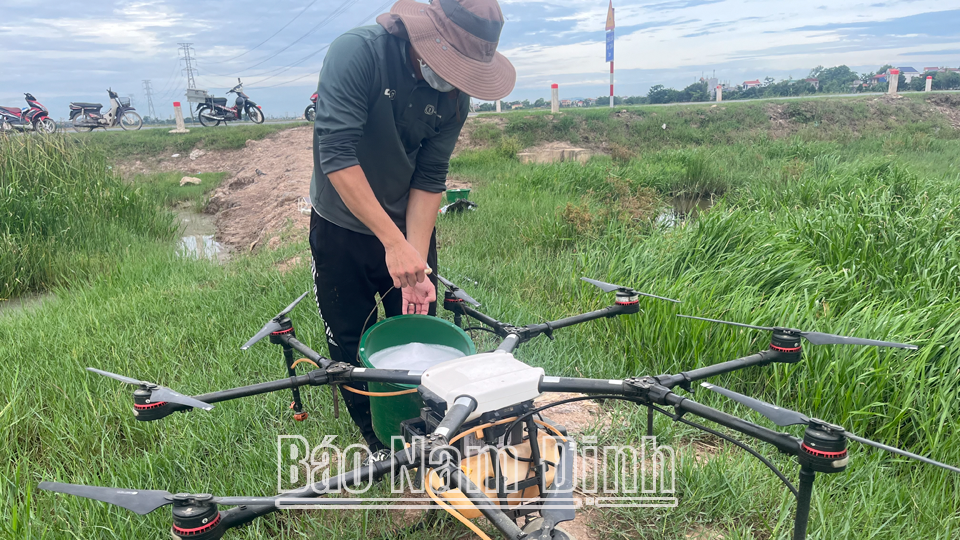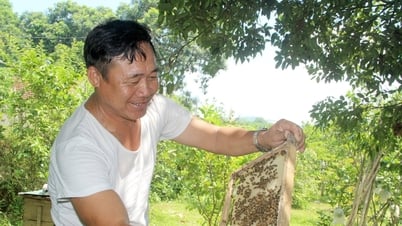 |
| Farmers in Dai An commune (Vu Ban) use drones to spray pesticides to protect spring rice. |
The weather in recent days has been favorable for rice fields to grow and develop, but it has also caused the emergence of pests and diseases that quickly damage spring rice. According to the assessment of the Department of Cultivation and Plant Protection (Department of Agriculture and Environment): Currently, the second generation of small leaf rollers is emerging, with a common density of 0.1-0.3 individuals/ m2 , in high places 1-3 individuals/ m2 , locally 5-7 individuals/ m2 ; egg density in high places 30-50 eggs/ m2 , locally 70-100 eggs/ m2 . It is forecasted that the density of eggs and larvae will continue to increase in the coming days; the second generation of larvae will hatch from May 1 to 7. The larvae will spread out for a long time, with a common density of 20-50 individuals/ m2 , in high places 100-200 individuals/ m2 , locally more than 300 individuals/ m2 ; The density of pests is equivalent to the average of many years and causes widespread damage to rice. This is the main pest in the spring crop, directly damaging the flag leaves. If not sprayed in time, it will cause great damage to rice yield. The second generation of planthoppers (mainly white-backed planthoppers) will bloom from April 30 to May 8, with a common density of 200-500 individuals/ m2 , in high places 2,000-3,000 individuals/ m2 , locally over 3,000 individuals/ m2 . Rice blast disease has appeared locally on susceptible varieties such as Nep, BC15, Dai Thom 8, TBR225, Bac Thom 7...; the disease rate is 5-10% in high places, locally 15-20%; the level of damage is higher than the same period last year. If not sprayed in time, it will cause rice stunting in the coming days; at the same time, brown spot disease and rats will continue to break out, causing damage on a large scale.
Based on the estimates and forecasts of specialized plant protection agencies, districts and cities focus on directing communes, towns, and agricultural service cooperatives to proactively deploy propaganda, guidance, and recommendations for farmers on timely and effective preventive spraying measures. Comrade Tran Dinh Vang, Head of the Department of Agriculture and Environment of Vu Ban district, said: Currently, spring rice is growing and developing well, early rice has begun to form panicles, and mass rice is in the period of intensive sowing to the end of tillering. However, the two-spotted stem borer has emerged early and poses a great risk of causing damage due to a large number of worms from the 2024 crop remaining on the stubble. When the weather is favorable, the worms develop rapidly, with a risk of causing severe damage over the entire area. In order to respond promptly, the Department has assigned staff to organize a review of the fields, delineate areas where worms appear at high densities, and quickly deploy instructions for local people to spray preventive and control pesticides in a timely manner. Households are clearly informed about the time, type of pesticide to use and spraying techniques according to the "4 rights" principle.
To ensure effective pest control and promote the effectiveness of pesticides, spraying is carried out simultaneously by cooperatives, spraying is carried out at the right time, minimizing spraying in the rain. Chairman of the Board of Directors of Bon Thuan Service Cooperative Hoang Van Bon, Hien Khanh Commune (Vu Ban) said: Based on the direction of the district, commune and instructions of specialized agencies, the technical staff of the cooperative always closely follows the fields, closely monitors the development of pests and diseases to support members in implementing the correct techniques. In particular, the cooperative encourages households to use drones to spray pesticides, improving the effectiveness of spraying and protecting the environment. Not only stem borers, rice blast disease is also at risk of spreading rapidly on rice varieties such as BC15, TBR225, glutinous rice varieties... The cooperative requires households to regularly check the fields and spray pesticides according to recommendations when signs of disease appear from 3-5%. The cooperative also strengthens technical guidance, spraying schedules, and post-spraying quarantine periods to ensure safety for people and spring rice.
Comrade Tran Ngoc Chinh, Head of the Department of Cultivation and Plant Protection, said: To ensure the safety of the 2025 spring rice crop, the Department recommends that the People's Committees and specialized agencies of districts and cities direct communes, towns, and agricultural cooperatives to strengthen propaganda work, instruct farmers to inspect fields, classify rice fields to have appropriate additional care measures, and note not to apply urea fertilizer when the rice is in the panicle - about to bloom to minimize the occurrence and damage of late-season pests and diseases, especially leaf blight in conditions of heavy rain and strong winds...
Focus on spraying to prevent leaf blast disease when it first appears and on areas that have been sprayed but still have acute disease lesions. Spray to prevent neck blast disease at flowering time, 3-5% of the number of flowers (spray first in fields that have flowered before, spray later in fields that have flowered after) for susceptible varieties such as: BC15, Nep, Khang Dan 18, TBR225, QR1, Q5, Thien Uu 8, Dai Thom 8, Phuc Thai 168... especially rice that flowered before May 15 and areas that have been infected with leaf blast disease, when the rice flowered and encountered rain. Use drugs containing the active ingredient Tricyclazole, other active ingredients, do not use drugs containing only 1 active ingredient Isoprothiolane to spray to prevent rice blast disease due to poor prevention effectiveness. Spray the second batch of small leaf rollers from May 1 to 7, 2025 for rice areas with a worm density of over 20 insects/ m2 (Spray early-planted rice at the beginning of the schedule, spray late-planted rice at the end of the schedule). Use drugs containing the active ingredient Indoxacarb or other active ingredients). After 5 days of spraying, check if the worm density is still over 50 insects/ m2 , spray again. Combine spraying the second batch of planthoppers for areas with a hopper density of over 30 insects/clump (1,000 insects/ m2 ); use drugs containing the active ingredients Nitenpyram, Pymetrozin, other active ingredients such as: Amira 25WP, Midan 10WP, Sectox 100WP... After 3 days of spraying, if the hopper density is still over 30 insects/clump (1,000 insects/ m2 ), spray again. Spray to prevent brown spot disease in areas where the disease has just appeared; Use drugs containing active ingredients Pencycuron, Hexaconazole, and other active ingredients. Farmers should note that if pests that need to be controlled appear at the same time, they can combine drugs but must maintain the same concentration of each type. If it rains within 4 hours after spraying, spray again.
Timely and effective spraying of pests and diseases at the end of the season will have a decisive impact on the yield and output of spring rice. Therefore, after each concentrated spraying of spring rice fields, localities need to quickly compile reports and organize field inspections to determine effectiveness and prepare well for the next care stage. At the same time, coordinate with specialized agencies to continue investigating, detecting, estimating and forecasting pests and diseases from now until the end of the season to have timely and effective prevention and control instructions, determined to strive for a successful 2025 spring rice crop.
Article and photos: Van Dai
Source: https://baonamdinh.vn/kinh-te/202504/chu-dong-phong-tru-sau-benhbao-ve-lua-xuan-85d4ab2/



![[Photo] The parade took to the streets, walking among the arms of tens of thousands of people.](https://vphoto.vietnam.vn/thumb/1200x675/vietnam/resource/IMAGE/2025/4/30/180ec64521094c87bdb5a983ff1a30a4)

![[Photo] Chinese, Lao, and Cambodian troops participate in the parade to celebrate the 50th anniversary of the Liberation of the South and National Reunification Day](https://vphoto.vietnam.vn/thumb/1200x675/vietnam/resource/IMAGE/2025/4/30/30d2204b414549cfb5dc784544a72dee)

![[Photo] Cultural, sports and media bloc at the 50th Anniversary of Southern Liberation and National Reunification Day](https://vphoto.vietnam.vn/thumb/1200x675/vietnam/resource/IMAGE/2025/4/30/8a22f876e8d24890be2ae3d88c9b201c)
















![[Photo] Performance of the Air Force Squadron at the 50th Anniversary of the Liberation of the South and National Reunification Day](https://vphoto.vietnam.vn/thumb/1200x675/vietnam/resource/IMAGE/2025/4/30/cb781ed625fc4774bb82982d31bead1e)

































































Comment (0)